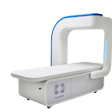
The U.S. Food and Drug Administration (FDA) created a new regulatory classification for artificial intelligence (AI)-guided image acquisition and optimization software earlier in February when it cleared a new AI-based echocardiography acquisition application. An FDA representative detailed the new rule in a talk Wednesday at a public workshop.
The clearance of Caption Health's Caption Guidance software on February 7 resulted in what the FDA categorizes as a new CAD device type: computer-aided acquisition/optimization (CADa/o). The new addition joins computer-aided detection (CADe), computer-aided diagnosis (CADx), computer-aided detection/diagnosis (CADe/x), and computer-assisted triage (CADt) software on the list of CAD device classifications regulated by the FDA.
Although the new software category initially applies to ultrasound imaging technology, the FDA does envision that it could be applied in the future to other imaging modalities and applications, according to Shahram Vaezy, PhD, a biomedical engineer in the Office of Product Evaluation and Quality's Division of Radiological Health.
De novo request
When the FDA granted Caption Health's de novo request for its software to be classified as a "Radiological acquisition and/or optimization guidance system," the agency also adopted special controls to establish a class II 510(k) regulatory pathway for subsequent devices of this type, Vaezy said.
Under the regulation, 21 CFR 892.2100, a radiological acquisition and/or optimization guidance system is a device that is intended in the acquisition and/or optimization of images and/or diagnostic signals. The device interfaces with the acquisition system, analyzes its output, and provides guidance and/or feedback to the operator for improving and image and/or signal quality. The images and/or signals must be read by a qualified healthcare professional, Vaezy said.
Applications for new products with this device classification will need to include a summary of the benefits and risks of the technology. Benefits include improved access to clinical care, improved performance, and patient convenience, while a summary of the risks include low image or signal quality and delayed clinical care if images aren't diagnostic quality.
Other factors considered in the risk-benefit analysis include how the technology can fill gaps in clinical care, as well as the patient perspective, according to Vaezy.
"By now it must be very obvious that the patient perspective is extremely important in this context," he said. "We need to know how the device impacts the balance of risk and benefit for clinical care and what level of uncertainty could be expected, anticipated, and perhaps accepted for a device that clearly has certain benefits and risks."
Risks and mediation methods
The regulation for these AI-based acquisition/optimization devices calls for consideration of risks along with methods for mediating this risk, Vaezy noted. The FDA has identified two specific types of risks, the first of which is a device error due to hardware failure or a problem in the algorithm that results in a failure to provide guidance or acquire diagnostic-quality images or signals.
"That would clearly lead to delay or prolonged examination or additional unnecessary procedures," Vaezy said.
The second risk is a user error in which an operator may not necessarily have followed the instructions provided by the system, he said. That could result in low-quality images that don't provide sufficient diagnostic information.
Special controls
The mitigation factors would be considered as part of the device type's special controls. These special controls encompass design verification and validation, as well as labeling:
- Design verification and validation: Must include a detailed device description, detailed report on nonclinical and clinical performance testing, documentation of an effective training program, and a detailed protocol for possible changes in the future
- Labeling: Must include a detailed description of the device, including information on all required and/or compatible parts; a detailed description of the patient population for which the device is intended for use; a detailed description of the intended user population and the recommended user training; detailed instructions for use, including the information provided in the training program; a warning that the images and data acquired using the device are to be interpreted only by qualified medical professionals; a detailed summary of required reports; and a statement on upholding the as low as reasonably achievable (ALARA) principle with a discussion on the associated device controls/options
The detailed report on clinical performance testing should include a thorough description of the testing protocols, a thorough quantitative evaluation of the performance in a representative user population and patient population under the anticipated conditions, and environments the software would be used in, Vaezy said. Thorough discussions on the generalizability of the clinical performance testing results and use-related risk analysis and human factors should also be included.
Submissions also must address future possible device modifications with a detailed protocol. This protocol should detail, in the event of a future change in the device, the technical specifications or indications for use at which the changes could significantly affect the effectiveness of the device and the risks posed by these changes. The assessment metrics, acceptance criteria, and analytical methods used for the performance testing of changes that are within the scope of the protocol must also be included.
This device modification protocol was primarily based on an April 2019 FDA white paper that proposed a regulatory framework for addressing modifications to AI- or machine learning-based software, Vaezy said.
Future considerations for CADa/o
Given the operator-dependent nature of ultrasound, the new regulation for AI-based acquisition/optimization devices would apply mostly to ultrasound imaging systems at the moment, according to Vaezy.
"We can envision, though, that it could cover other imaging modalities as well," he said. "As far as we're concerned on what would be acceptable under this regulation, it could include other indications for use and clinical applications, it could include other users, perhaps patients in a home use environment, and it could include other technological features as well, like measurements and analyses."
However, performance testing would need to be specific to the device type in the submission, he said. Vaezy also encouraged software developers to communicate early on with the FDA once they have well-defined plans in place for the device's characteristics, intended use, and performance testing.
"We will be happy to discuss with you and engage with you and help you in your regulatory path," he said.




















